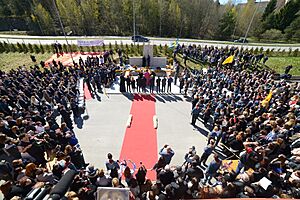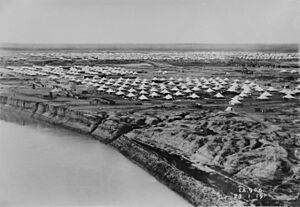Sayfo facts for kids
The Sayfo (Syriac: ܣܲܝܦܵܐ, lit. sword), also known as the Seyfo or the Assyrian genocide, was the mass slaughter and deportation of Assyrian/Syriac Christians in southeastern Anatolia and Persia's Azerbaijan province by Ottoman forces and some Kurdish tribes during World War I.
Contents
Overview
The Assyrians were divided into mutually antagonistic churches, including the Syriac Orthodox Church, the Assyrian Church of the East, and the Chaldean Catholic Church. Before World War I, they lived in mountainous and remote areas of the Ottoman Empire, some of which were effectively stateless. The empire's nineteenth-century centralization efforts led to increased violence and danger for the Assyrians.
Mass killing of Assyrian civilians began during the Ottoman occupation of Azerbaijan from January to May 1915, during which massacres were committed by Ottoman forces and pro-Ottoman Kurds. In Bitlis province, Ottoman troops returning from Persia joined local Kurdish tribes to massacre the local Christian population (Armenians and Assyrians). Ottoman forces and Kurds attacked the Assyrian tribes of Hakkari in mid-1915, driving them out by September despite the tribes mounting a coordinated military defense. Governor Mehmed Reshid initiated a genocide of all of the Christian communities in Diyarbekir province, including Syriac Christians, facing only sporadic armed resistance in some parts of Tur Abdin. Ottoman Assyrians living farther south, in present-day Iraq and Syria, were not targeted in the genocide.
The Sayfo occurred concurrently with and was closely related to the Armenian genocide, although the Sayfo is considered to have been less systematic. Local actors played a larger role than the Ottoman government, but the latter also ordered attacks on certain Assyrians. Motives for killing included a perceived lack of loyalty among some Assyrian communities to the Ottoman Empire and the desire to appropriate their land. At the 1919 Paris Peace Conference, the Assyro-Chaldean delegation said that its losses were 250,000, about half the prewar population. The accuracy of this figure is unknown. They later revised their estimate to 275,000 dead at the Lausanne Conference in 1923. The Sayfo is less studied than the Armenian genocide. Efforts to have it recognized as a genocide began during the 1990s, spearheaded by the Assyrian diaspora. Although several countries acknowledge that Assyrians in the Ottoman Empire were victims of a genocide, this assertion is rejected by the Turkish government.
Terminology
There is no universally accepted translation in English for the endonym Suryoyo or Suryoye. The choice of which term to use, such as Assyrian, Syriac, Aramean, and Chaldean, is often determined by political alignment. The Church of the East was the first to adopt an identity derived from ancient Assyria. The Syriac Orthodox Church has officially rejected the use of Assyrian in favor of Syrian since 1952, although not all Syriac Orthodox reject Assyrian identity.
Since the Ottoman Empire was organized by religion, Ottoman officials referred to populations by their religious affiliation rather than ethnicity. Therefore, according to historian David Gaunt, "speaking of an 'Assyrian Genocide' is anachronistic". In Neo-Aramaic, the languages historically spoken by Assyrians, it has been known since 1915 as Sayfo or Seyfo (ܣܝܦܐ, lit. sword), which, since the tenth century, has also meant 'extermination' or 'extinction'. Other terms used by some Assyrians include nakba (Arabic for 'catastrophe') and firman (Turkish for 'order', as Assyrians believed that they were killed according to an official decree).
Aftermath
Exile in Iraq

During the journey to Hamadan, the Assyrians were harassed by Kurdish irregulars (probably at the instigation of Simko and Sayyid Taha); some died of exhaustion. Many were killed near Heydarabad, and another 5,000 during an ambush by Ottoman forces and Kurdish irregulars near the Sahin Ghal'e mountain pass. Dependent on the British for protection, they were resettled in a refugee camp in Baqubah (near Baghdad) which held fifteen thousand Armenians and thirty-five thousand Assyrians in October 1918. Conditions at the camp were poor, and an estimated 7,000 Assyrians died there. Although the United Kingdom requested that Assyrian refugees be allowed to return, the Persian government refused.
In 1920, the camp in Baqubah was shut down and Assyrians hoping to return to Azerbaijan or Hakkari were sent northwards to Midan. About 4,500 Assyrians were resettled near Duhok and Akre in northern Iraq. They worked as soldiers for the British rulers of Mandatory Iraq, which backfired when the British did not follow through with their repeated promises to resettle Assyrians in areas where they would be safer. After the end of the mandate, Assyrians were killed in the 1933 Simele massacre. After the massacre, France allowed 24,000 to 25,000 Assyrians to resettle along the Khabur in northeastern Syria. Other Assyrians were exiled in the Caucasus, Russia, or Lebanon, and a few immigrated to the United States, Canada, South America, and Europe.
Assyrians in Turkey
A few thousand Assyrians remained in Hakkari after 1915, and others returned after the war. Armed by the British, Agha Petros led a group of Assyrians from Tyari and Tkhuma who wanted to return in 1920; he was repulsed by Barwari chieftain Rashid Bek and the Turkish army. The remaining Assyrians were driven out again in 1924 by a Turkish army commanded by Kazim Karabekir, and the mountains were depopulated. In Siirt, Islamicized Syriacs (primarily women) were left behind. Their Kurdified (or Arabized) descendants still live there.
The survivors lost access to their property, becoming landless agricultural laborers, or later, an urban underclass. The depopulated Christian villages were resettled by Kurds or Muslims from the Caucasus. During and after the genocide, more than 150 churches and monasteries were demolished. Others were converted to mosques or other uses. Many manuscripts and cultural objects were destroyed.
After 1923, local politicians went on an anti-Christian campaign which negatively impacted the Syriac communities (such as Adana, Urfa or Adiyaman) unaffected by the 1915 genocide. Many were forced to abandon their property and flee to Syria, eventually settling in Aleppo, Qamishli, or the Khabur region. Despite its effort to court the Turkish nationalists, including denying that Syriac Orthodox had been persecuted during the war, the Syriac Orthodox patriarchate was expelled from Turkey in 1924. Unlike the Armenians, Jews, and Greeks, Assyrians were not recognized as a minority group in the 1923 Treaty of Lausanne.
The remaining population lived in submission to Kurdish aghas, subject to harassment and abuse which drove them to emigrate. Turkish laws denaturalized those who had fled and confiscated their property. Despite their citizenship rights, many Assyrians who remained in Turkey had to re-purchase their property from Kurdish aghas or risk losing their Turkish citizenship. A substantial number of Assyrians continued to live in Tur Abdin until the 1980s. Some scholars have described the ongoing exclusion and harassment of Assyrians in Turkey as a continuation of the Sayfo.
Paris Peace Conference

In 1919, Assyrians attended the Paris Peace Conference and attempted to lobby for compensation for their war losses. Although it has been labeled "the Assyrian delegation" in historiography, it was neither an official delegation nor a cohesive entity. Many attendees demanded monetary reparations for their war losses and an independent state, and all emphasized that Assyrians could not live under Muslim rule. Territory claimed by the Assyrians included parts of present-day Turkey, Iraq, and Iran.
Although there was considerable sympathy for the Assyrians, none of their demands were met. The British and the French had other plans for the Middle East, and the rising Turkish nationalist movement was also an obstacle. The Assyrians recalled that the British had promised them an independent country in exchange for their support, although it is disputed if such a promise was ever made; many Assyrians felt betrayed that this desire was not fulfilled.
Death toll
Assyrian delegates at the Paris Peace Conference said that their losses were 250,000 in the Ottoman Empire and Persia, around half of the prewar population. In 1923, at the Lausanne Conference, they raised their estimate to 275,000. The source of these numbers is unknown and, according to Gaunt, their accuracy has been impossible to verify and the Assyrian delegation had an incentive to exaggerate. Although more than 50 percent of the population was killed in some areas, Assyrian communities in present-day Syria and Iraq were left mainly intact. The Sayfo was less systematic than the Armenian genocide; all Christians were killed in some places, but local officials spared Assyrians and targeted Armenians in others.
| Region | Losses | Notes |
|---|---|---|
| Persia | 40,000 | Gaunt says that this number is probably an overestimate, and there is no reliable figure. According to historian Donald Bloxham, "perhaps 7,000 Persian Assyrians" were killed in 1915. A German observer estimated that 21,000 Christians were killed in Azerbaijan between December 1914 and February 1915. |
| Van (including Hakkari) | 80,000 | According to Gaunt, "This is a very high figure and should be treated with caution". Russian consul Basil Nikitin estimated that 45,000 Assyrians from Hakkari fled to Persia, out of more than 70,000 prewar residents. |
| Diyarbekir | 63,000 | Catholic priest Jacques Rhétoré estimated that 60,725 Syriac Orthodox, 10,010 Chaldeans, 3,450 Syriac Catholics, and 500 Protestants were killed, of 144,185 total Christian deaths in Diyarbekir. British Army officer Edward Noel estimated 96,000 Syriac Orthodox, 7,000 Chaldeans, 2,000 Syriac Catholics, and 1,200 Protestants out of 157,000 Christian deaths. |
| Harput | 15,000 | According to historian Raymond Kévorkian, Assyrians were spared from deportation from Harput; Gaunt says that the Armenian genocide in Harput became a Christian one. |
| Bitlis | 38,000 | Rhétoré estimated that before the war, 60,000 Christians lived in Siirt district (including 15,000 Chaldeans and 20,000 Syriac Orthodox). The Syriac Orthodox Church estimated its losses at 8,500 in the province. |
| Adana, Der Zor and elsewhere | 5,000 | Gaunt lists Adana as a place where the Assyrian population was untouched by the Sayfo. |
| Urfa | 9,000 | Gaunt also lists Urfa as a place where the Assyrian population was not affected by the Sayfo. |
| Total | 250,000 | — |
Legacy


For Assyrians, the Sayfo is considered the greatest modern example of their persecution. Eyewitness accounts of the genocide were typically passed down orally, rather than in writing; memories were often passed down in lamentations. After large-scale migration to Western countries (where Assyrians had greater freedom of speech) during the second half of the twentieth century, accounts began to be communicated more publicly by grandchildren of survivors.
International recognition
The Sayfo is less well known than the Armenian genocide, partially because its targets were divided among mutually-antagonistic churches and did not develop a collective identity. During the 1990s, before the first academic research on the Sayfo, Assyrian diaspora groups (inspired by campaigns for Armenian genocide recognition) began to press for a similar formal acknowledgement. In parallel with the political campaign, Armenian genocide research began to include Assyrians as victims. In December 2007, the International Association of Genocide Scholars passed a resolution recognizing the Assyrian genocide. The Sayfo is also recognized as a genocide in resolutions passed by Sweden (in 2010), Armenia (2015), the Netherlands (2015), and Germany (in 2016). Memorials in Armenia, Australia, Belgium, France, Greece, Sweden, Ukraine, and the United States commemorate victims of the Sayfo.
Denial and justification
The Turkish government denies that the Sayfo was a genocide; unlike its denial of the Armenian genocide, however, it prefers to avoid the issue.
Images for kids
-
Syriac Orthodox family in Mardin, 1904














